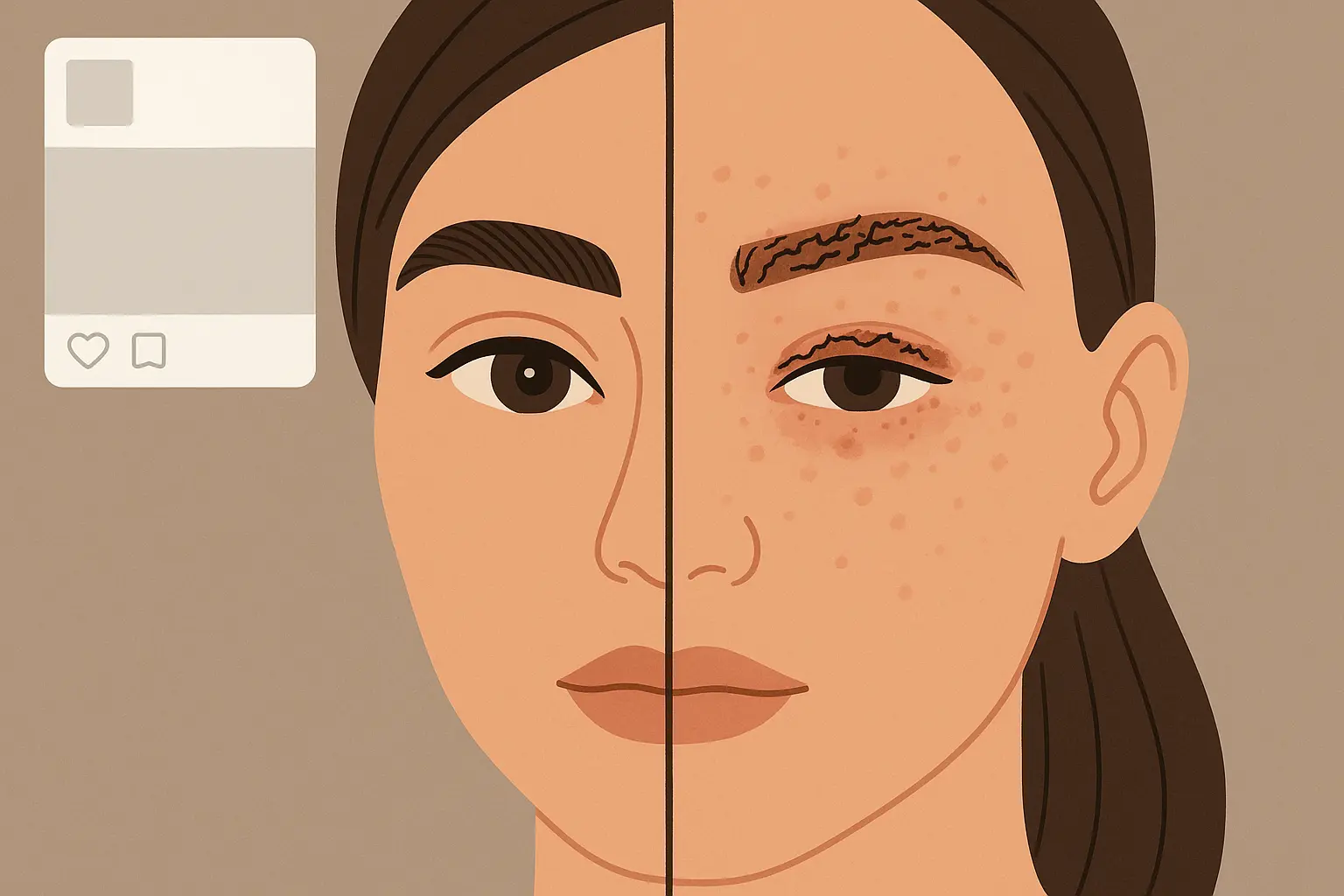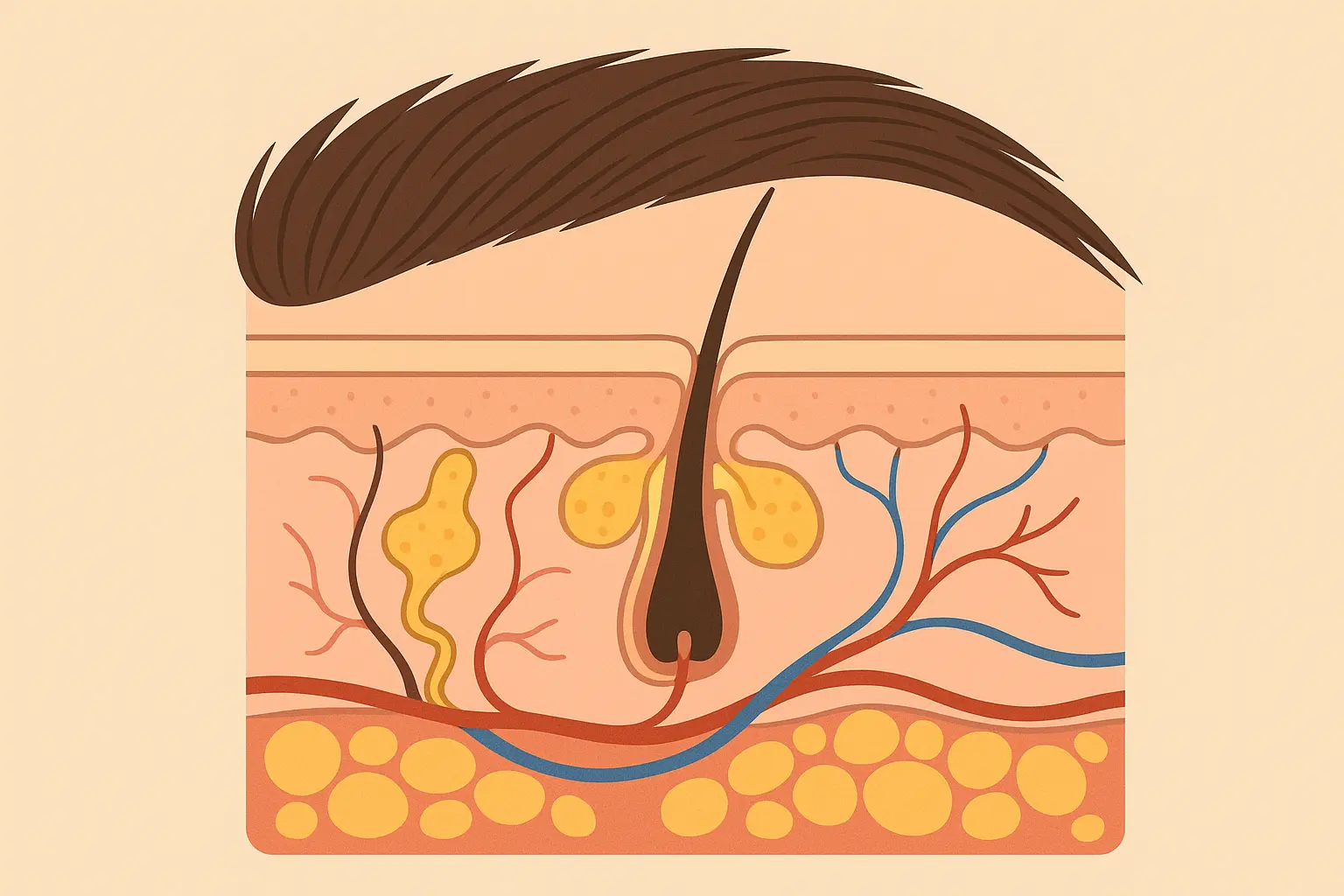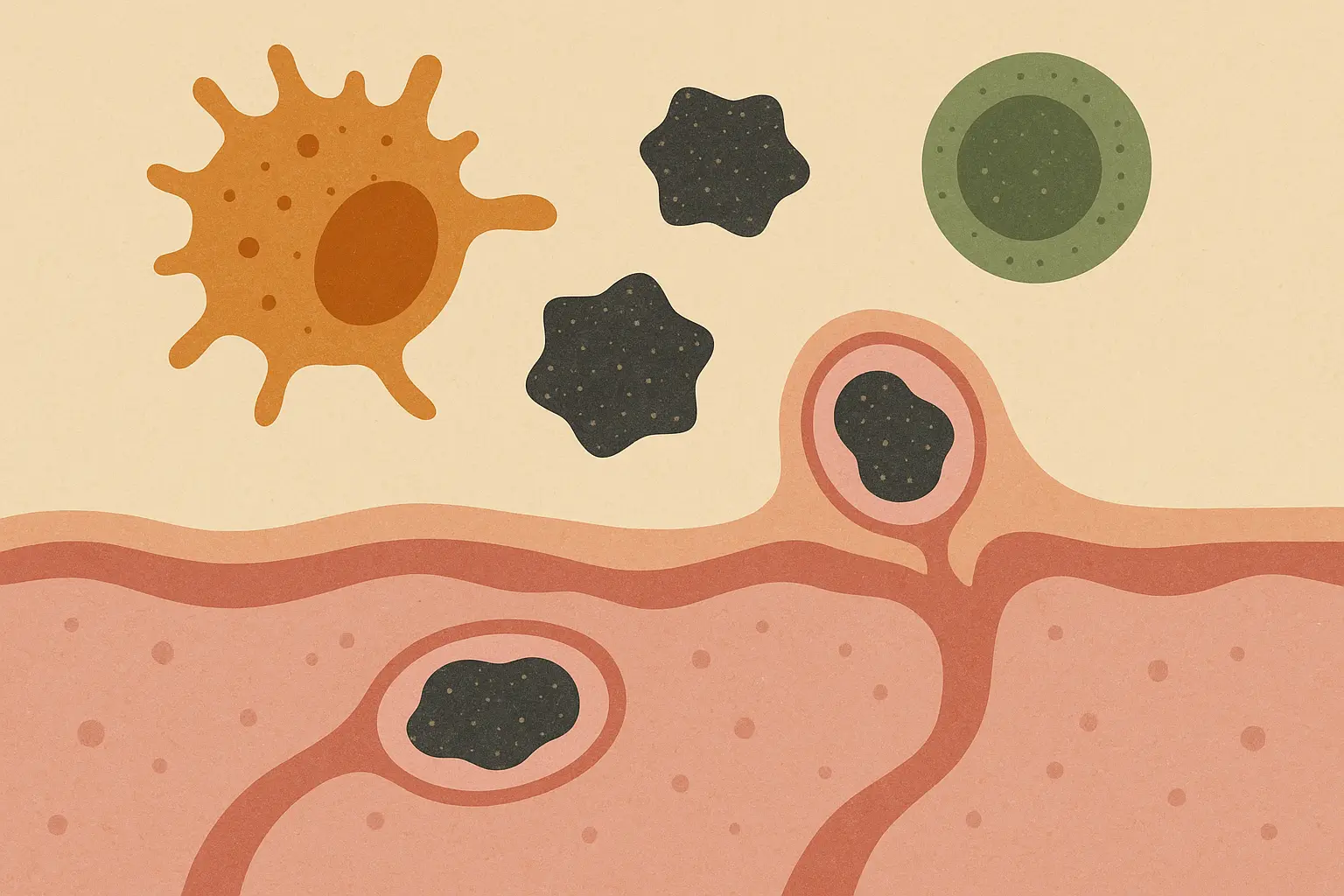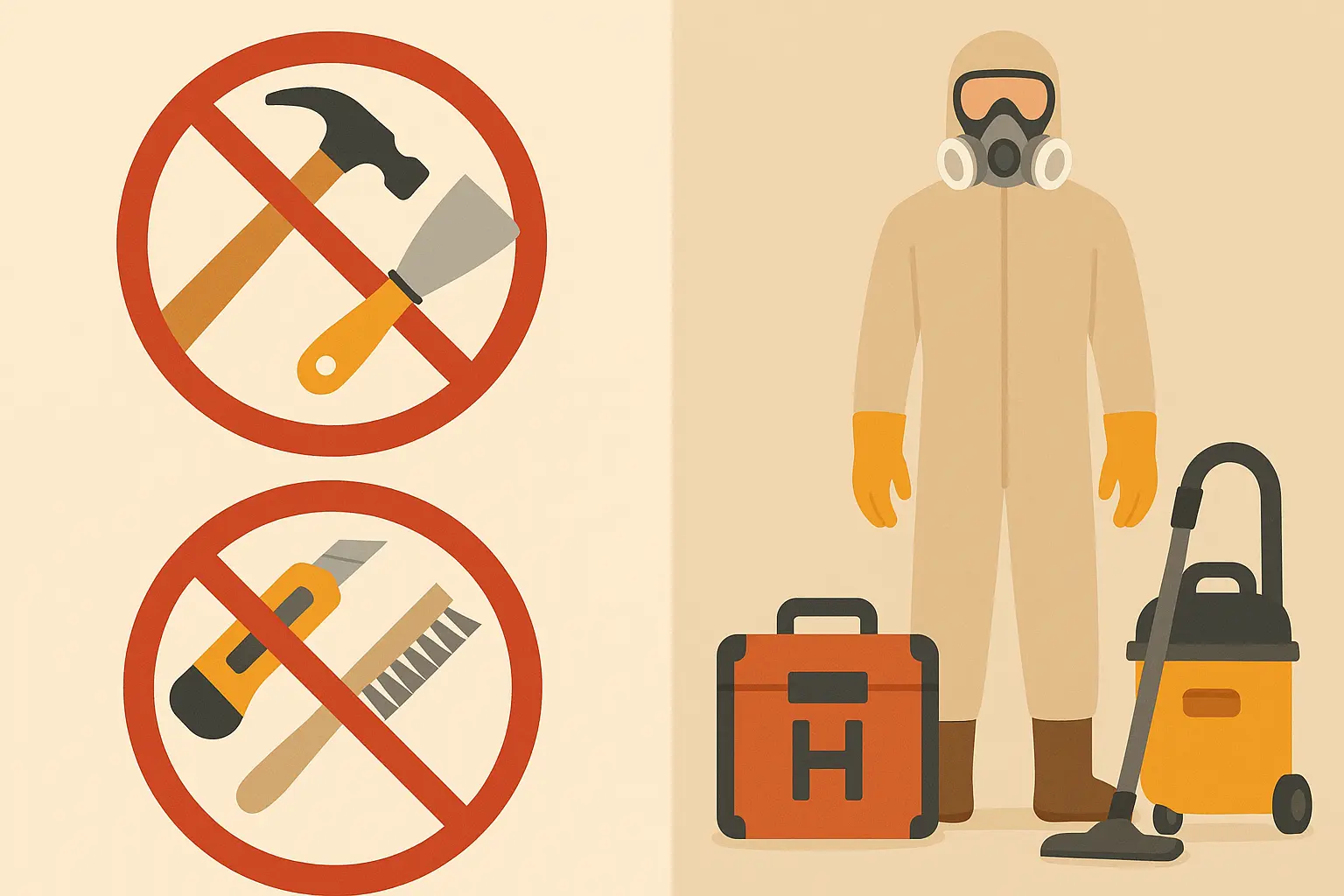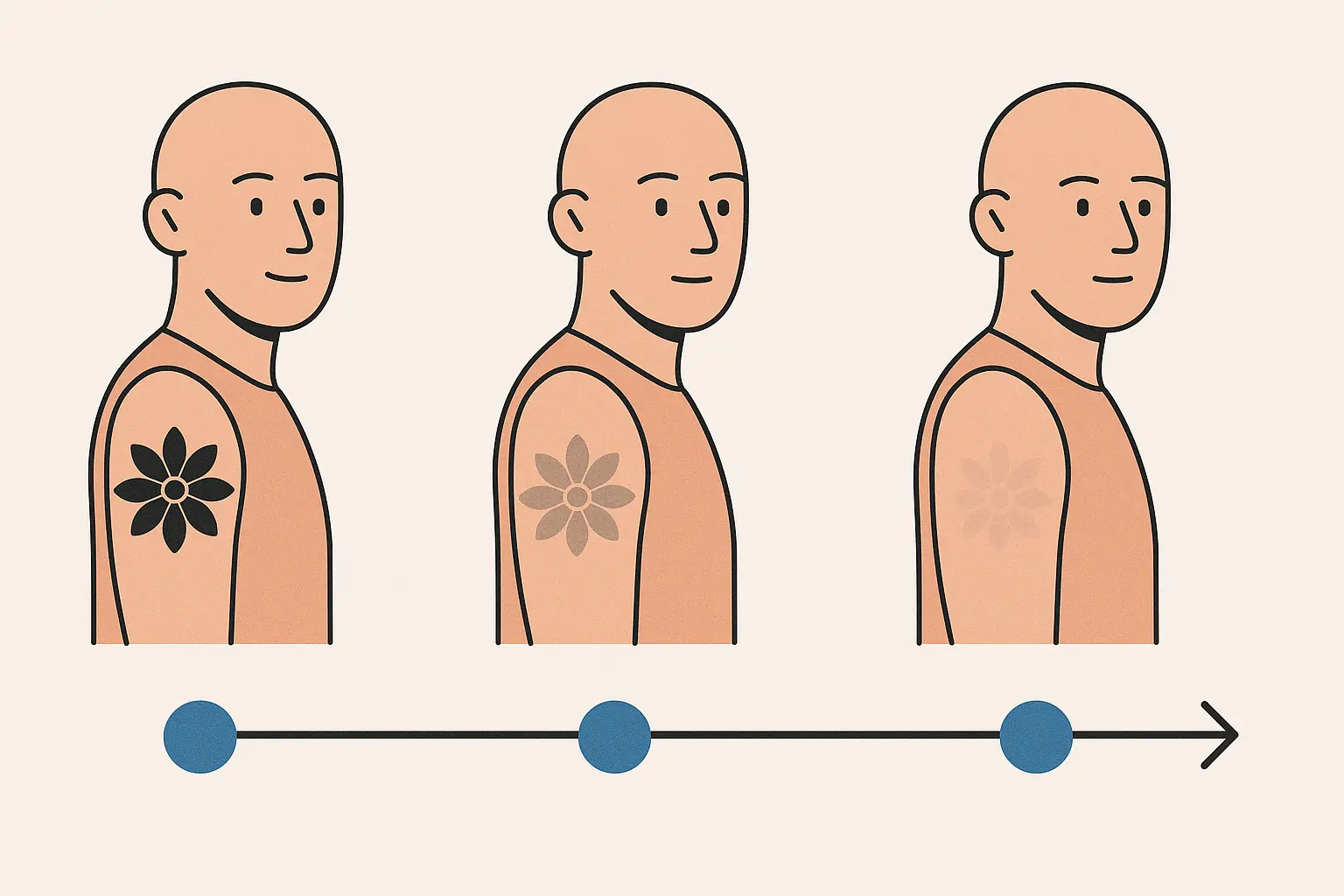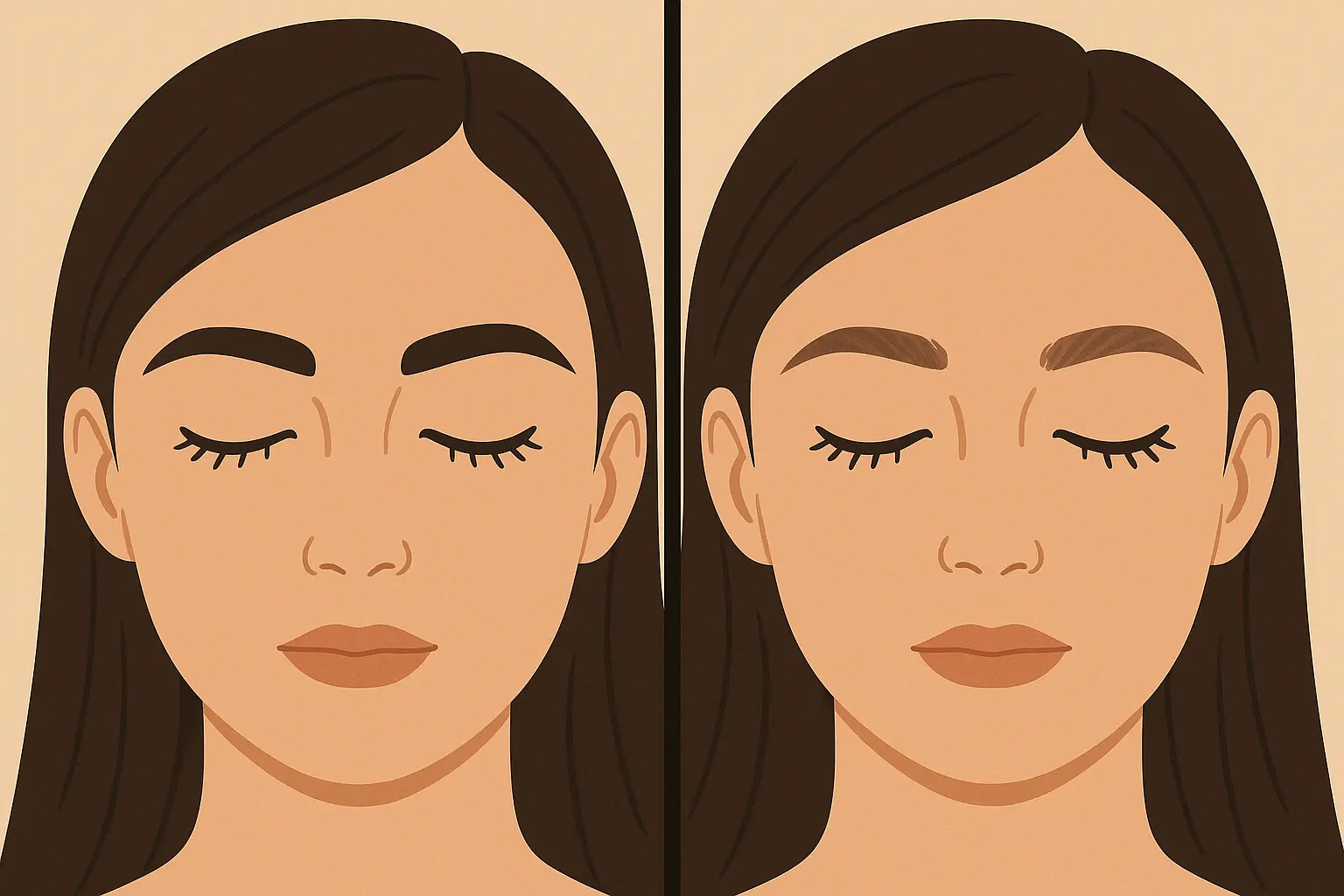Eyebrow Tattoo Removal: The Brutal Truth About What Nobody Tells You Before You Start
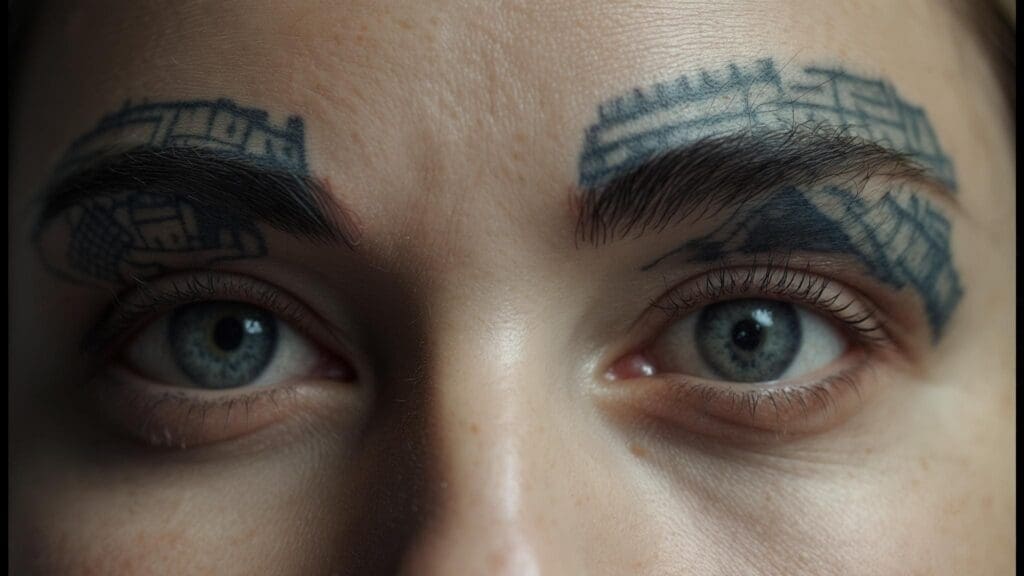
The global tattoo removal market was valued at USD 314.44 million in 2022 according to Straits Research, and it’s expected to reach USD 1,550.87 million by 2031. This explosive growth isn’t driven by body art regret alone – it’s fueled largely by the eyebrow tattoo removal crisis sweeping across beauty clinics worldwide. While perfect, permanent brows seemed irresistible just a few years ago, the reality of removal has become a billion-dollar industry built on broken beauty dreams.
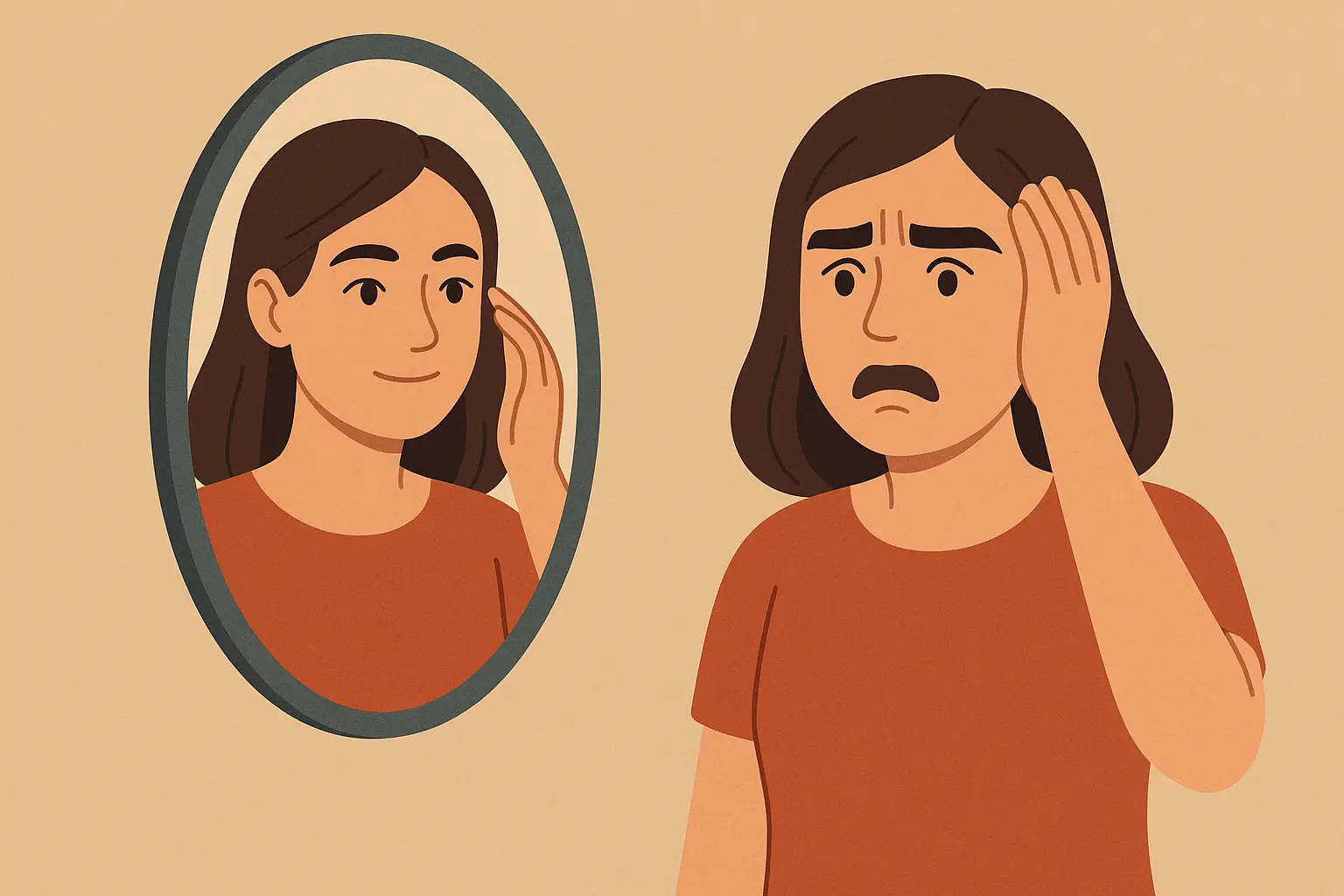
Table of Contents
-
Why You Hate Your Eyebrows So Much (And It’s Not Just Vanity)
-
The Gross Science of Why Your Brows Won’t Just Disappear
-
Why Even the Fanciest Lasers Can’t Promise Perfect Results
-
Planning Your Removal Strategy (Because Winging It Costs More)
-
The Real Cost of Removal (Spoiler: It’s Not Just Money)
-
DIY Removal Methods That’ll Ruin Your Face Forever
-
What Actually Happens During Professional Removal
-
How Tattoo Generator IQ Prevents This Nightmare
TL;DR
-
Your eyebrow tattoo regret isn’t just about looks – it’s trend fatigue, social pressure, and workplace discrimination that make you feel trapped
-
Your face is basically the worst place for tattoo removal because of all the blood vessels, oil glands, and weird drainage patterns
-
Some pigments (especially the “natural” brown ones) can turn black, shift colors, or become impossible to remove no matter what laser you use
-
The newest picosecond lasers are amazing but still can’t guarantee your tattoo will completely disappear
-
You’re looking at $5,000-8,000 minimum when you factor in all the hidden costs, time off work, and potential complications
-
Those DIY removal methods on YouTube will literally burn your face off – don’t even think about it
-
Less than half of people get complete removal – “good enough” is more realistic than perfect
-
Getting the design right the first time saves you from this expensive, painful nightmare
Why You Hate Your Eyebrows So Much (And It’s Not Just Vanity)
Look, getting your eyebrows removed isn’t just about not liking how they look anymore. There’s a whole mess of feelings involved that nobody warns you about, and it goes way deeper than simple buyer’s remorse.
The Mind Games Behind Permanent Makeup Regret
This isn’t just “oops, I don’t like my brows anymore.” We’re talking about genuine mental health stuff that happens when the face you see in the mirror doesn’t match who you feel like inside.
When Beauty Trends Become Identity Prisons
You know that sinking feeling when you look at old photos and cringe at your fashion choices? Now imagine those choices were tattooed on your face. That’s exactly what happened to thousands of people who got eyebrow tattoos during the peak Instagram brow era.
I remember talking to Lisa, who came in literally crying about her brows. She’d gotten them done right before her wedding in 2019 – you know, those super bold Instagram brows everyone was obsessed with. Fast forward to 2023, and she’s working at a law firm where the partners keep making comments about “professional appearance.” She felt like she was wearing a costume she couldn’t take off.
That awful feeling when you look in the mirror and think “that’s not me” has an actual name – aesthetic dysphoria. It’s not vanity; it’s a real disconnect between your inner self and what you see every morning. The psychological impact can be overwhelming when everyone around you starts embracing natural, feathery brows and you’re stuck with sharp, Instagram-ready arches.
The trend reversal is happening everywhere. Briar Neville from Sacred Laser in Auckland reports that she “sees about 20 clients each week for eyebrow tattoo removal” according to RNZ, with a major increase following COVID restrictions in 2023 as people reassess their appearance choices.
Social Media’s Cruel Reality Check
Here’s what nobody warns you about: those gorgeous eyebrow tattoo photos flooding your Instagram feed? They’re often heavily filtered, professionally lit, and captured at the absolute perfect moment in the healing process.
I’ve seen clients spiral into panic mode because their day-three healing brows looked nothing like the flawless results they’d screenshotted from social media. You’re comparing your swollen, scabby reality to someone else’s perfectly healed, perfectly lit, perfectly edited final result. It’s comparing your behind-the-scenes to everyone else’s highlight reel, except it’s on your face.
The “holy crap, what did I do” moment hits hard. You expect to wake up with those perfect brows you saw online, but instead you’re dealing with the very normal (but very unglamorous) healing process. Some people make removal decisions during this vulnerable period, before their tattoo has even had a chance to settle into its final form.
When Society Judges Your Face Choices
The cultural judgment is real, and it affects way more than just your feelings. We’re talking career impacts and family drama that can completely overshadow any aesthetic benefits.
The Career Cost Nobody Mentions
This is the conversation nobody wants to have, but I’m going to say it: your eyebrow tattoos might be screwing with your career, and you might not even realize it.
In conservative industries – think law, finance, traditional corporate environments – there’s still an unspoken bias against obvious permanent makeup. It’s not fair, it’s not right, but it’s real. I’ve heard from clients who noticed subtle changes in how colleagues treated them, missed out on client-facing opportunities, or felt passed over for promotions after getting their brows done.
The discrimination is rarely overt. Nobody’s going to tell you directly that your eyebrows are the problem. Instead, you might hear feedback about “professional image” or “client expectations.” You might notice you’re not getting invited to important meetings or client dinners. The impact is real, even if it’s never explicitly stated.
Take Sarah, a 34-year-old marketing manager who got bold, Instagram-style brows in 2019. By 2023, her company’s new conservative CEO made pointed comments about “professional appearance standards” during team meetings. Sarah noticed she was excluded from client presentations and eventually realized her career advancement was stalling. The $400 she spent on eyebrow tattoos cost her an estimated $15,000 in lost promotion opportunities, driving her decision to spend $2,500 on removal.
Family Drama Over Face Ink
The generational divide around permanent makeup is brutal, and it affects way more than just family dinners.
I’ve counseled clients whose parents refuse to be in photos with them, whose in-laws make passive-aggressive comments, and whose partners face family pressure about their “inappropriate” appearance choices. In traditional or religious communities, the judgment can be overwhelming.
One client told me her grandmother literally cried when she saw her new eyebrows, saying she looked “like a streetwalker.” Another described constant tension with her mother-in-law, who would make pointed comments about “natural beauty” every time they met. The psychological burden of constant explanation, judgment, and family disapproval can completely overshadow any aesthetic benefits.
The worst part? These aren’t necessarily bad people being intentionally cruel. They’re operating from different cultural frameworks where permanent makeup carries stigma. But when you’re living with that judgment every day, the emotional cost can become unbearable.
The Gross Science of Why Your Brows Won’t Just Disappear
Your face is basically the worst place for tattoo removal, and I’m about to tell you why. The biology of facial skin makes eyebrow removal way more complicated than zapping ink off your arm or leg.
Your Face Isn’t Just Thinner Skin
Facial skin is like a completely different organ compared to the rest of your body, and that creates unique challenges that most people don’t understand until they’re deep in the removal process.
Blood Flow That Works Against You
Your face has way more blood vessels than the rest of your body – which sounds like it should help with tattoo removal, right? Unfortunately, it’s way more complicated than that.
The eyebrow area gets blood supply from multiple directions, creating this incredibly dense network of vessels. When laser treatment basically explodes the ink particles, they have tons of different pathways to circulate through your system. You’d think this would speed up removal, but facial drainage works differently than body drainage.
Your face drains into your neck and jaw lymph nodes through these weird circulation loops that sometimes trap broken-up ink particles instead of clearing them out efficiently. This is why eyebrow removal often takes more sessions than similar-sized body tattoos, even though the area is tiny.
The rich blood supply also means more swelling, more bruising, and longer healing times between sessions. What looks like a simple zap-and-go procedure becomes this complex biological process that your practitioner might not fully explain upfront.
Oil Glands That Trap Ink
Here’s something most removal consultations won’t mention: your eyebrow area is packed with oil glands that actively work against the removal process.
These oil glands are constantly producing oils, and over time, they can actually wrap ink particles in tiny oil bubbles. It’s like trying to break something that’s wrapped in bubble wrap – the protection layer absorbs some of the laser impact.
But here’s where it gets weird: those same oil glands can also cause your tattoo to fade naturally over time through constant low-level inflammation. So you might notice your brows getting lighter on their own, but when you try laser removal, those oil-wrapped particles become stubborn and resistant to treatment.
The oil production also screws with healing between sessions. Some people develop clogged pores or small breakouts around their brow area during removal, which can mess with the treatment schedule and potentially affect final results.
Why Your Ink Chemistry Matters More Than Color
So here’s the thing about those “natural brown” inks – they’re basically made of rust. And when you hit rust with laser energy, sometimes it rusts more instead of breaking down. Different pigments react in completely unpredictable ways that can make your removal journey a nightmare.
When Brown Turns Black (And Stays That Way)
This is probably the most shocking thing clients discover during eyebrow tattoo removal: their brown eyebrows can turn black after the first laser session. And sometimes they stay that way.
The moment you realize your brown eyebrows just turned black after your first laser session? That’s a special kind of panic. Your practitioner might have mentioned this could happen, but hearing it and living it are two completely different things. You’re standing in your bathroom at 7 AM, late for work, staring at these dark, angry-looking brows thinking “What have I done?”
Iron oxide is the most common pigment in brown eyebrow tattoos, and when laser energy hits it, the heat can actually cause chemical reactions that darken the pigment before breaking it down. It’s like when iron rusts – the chemical change creates a darker, sometimes more stable compound.
Red pigments are especially problematic because they can shift to orange or even purple during treatment. The laser energy doesn’t just break down the pigment – it can actually change its chemical structure, creating colors that weren’t there before and might be even harder to remove than the original tattoo.
In a comprehensive study of 98 patients undergoing eyebrow tattoo removal, researchers found that visible orange, red, and yellow pigments were found in 42 eyebrow cosmetic tattoos, with warm pigments requiring significantly more sessions for removal (3.57 vs. 2.25 sessions) compared to tattoos without these challenging colors.
The White Pigment Problem Nobody Talks About
If your eyebrow tattoo has any white or flesh-toned highlighting, I have bad news: those parts might be permanent.
Titanium dioxide is the same stuff they put in sunscreen specifically because it resists light degradation. When tattoo artists use it for highlighting or to create flesh-toned colors, they’re essentially putting sunscreen under your skin. Laser energy can’t break it down the same way it breaks down other pigments.
Worse yet, when laser heat hits titanium dioxide, it can actually become more opaque and visible. I’ve seen cases where people had subtle flesh-toned tattoos that became bright white patches after laser treatment. The removal process literally made the problem worse.
This is why it’s crucial to know exactly what pigments were used in your original tattoo. Some “organic” or “natural” inks still contain titanium dioxide, and practitioners might not realize this until they start treatment and see unexpected results.
|
Pigment Type |
Common Colors |
Removal Difficulty |
Sessions Needed |
Potential Complications |
|---|---|---|---|---|
|
Iron Oxide |
Brown, Red, Yellow |
Moderate to High |
3-6 sessions |
Color darkening, shifting to black |
|
Carbon Black |
Black |
Low to Moderate |
2-4 sessions |
Generally responds well |
|
Titanium Dioxide |
White, Flesh-tone |
Very High |
Often permanent |
May become more visible |
|
Organic Azo |
Red, Orange, Yellow |
High |
4-8 sessions |
Color shifting, resistance |
|
Chromium Oxide |
Green |
Moderate |
3-5 sessions |
Requires specific wavelengths |
Your DNA Affects Your Removal Success
Your genes play a huge role in removal success, but nobody tests for this stuff before starting treatment. It’s like playing genetic lottery, and you don’t find out if you won or lost until you’re thousands of dollars in.
Genetic Lottery Winners and Losers
Some people have genetic variations that make them amazing at clearing ink particles – their immune systems are like tiny Pac-Men gobbling up laser-shattered pigment. Others have genetic markers that make them prone to dark spots or light spots from laser treatment.
The frustrating part is that you can’t predict this from skin
The frustrating part is that you can’t predict this from skin tone alone. I’ve seen people with similar complexions have completely different removal experiences because of underlying genetic differences in how their skin responds to laser energy.
There are genetic tests that could predict some of these responses, but they’re not standard practice in the tattoo removal industry. Most practitioners rely on visual assessment and patch testing, which doesn’t always reveal genetic predispositions that might screw with your final results.
When Your Immune System Fights Back
Sometimes your immune system decides that tattoo ink is a foreign invader that needs to be contained, and this can make removal way more complicated.
This autoimmune response creates chronic low-level inflammation that can wrap ink particles in fibrous tissue. Your body builds tiny prisons around the ink, making it inaccessible to laser treatment. The laser energy can’t reach through the scar tissue to shatter the pigment effectively.
People with this response often notice their tattoos changing color or texture over time, even before starting removal. The ongoing inflammation can cause the skin to feel slightly raised, look slightly discolored, or develop texture changes that persist even after successful pigment removal.
The tricky part is that this immune response can develop months or years after getting tattooed. You might have a perfectly normal healing process initially, then develop problems later that make removal much more challenging than expected.
Why Even the Fanciest Lasers Can’t Promise Perfect Results
Despite all the fancy technology and marketing promises, even the most expensive, newest laser equipment can’t guarantee your eyebrow tattoo will completely disappear. Let me break down why these machines have limits, no matter how much you pay.
Picosecond Lasers: The Current Gold Standard
Picosecond lasers are the Ferrari of removal equipment – they’re fast, precise, and cost a fortune to operate. But even Ferraris can’t drive through brick walls, and some tattoo pigments are basically brick walls.
Wavelength Wars: Why One Size Doesn’t Fit All
Modern picosecond lasers aren’t one-trick ponies – they come loaded with multiple wavelengths, and choosing the right one makes or breaks your removal success.
The 532nm wavelength absolutely destroys red and orange pigments, but it can also destroy your natural skin pigment if you have a darker complexion. I’ve seen people end up with permanent light spots because their practitioner used the wrong wavelength for their skin tone.
The 755nm wavelength excels at targeting green and blue pigments (which you might have if your brown tattoo has shifted colors), but it might not penetrate deep enough if your tattoo was placed in the deeper skin layers. It’s like having a really good surface cleaner when you need something that can reach the basement.
The 1064nm wavelength is the safest for darker skin tones, but it can be frustratingly slow on lighter pigments. You might need twice as many sessions to see the same results you’d get with other wavelengths on lighter skin.
Here’s what’s really frustrating: most practitioners don’t explain these trade-offs upfront. They just tell you they have “the latest eyebrow laser technology” without discussing why your specific pigment-skin combination might need a particular approach.
Research shows that the 532nm wavelength was required for 34% of patients when red, orange, or yellow pigments didn’t respond to 755nm treatment, demonstrating how pigment-specific wavelength selection directly impacts treatment success.
The Pressure Wave Problem
Picosecond lasers work by creating pressure waves that literally explode ink particles – sounds awesome, right? But those same pressure waves can cause problems you weren’t expecting.
The mechanical action is intense enough to cause immediate swelling and bruising that can last weeks. I’m talking about swelling so severe that some people can’t open their eyes properly for days after treatment. The pressure can also cause temporary changes in skin texture that make you look like you’ve been in a fight.
But here’s the really concerning part: sometimes those pressure waves can actually push ink particles deeper into your skin layers. Instead of breaking them up for removal, the mechanical force drives them further down where they become even harder to reach with subsequent treatments.
This is why some people see great results from their first few sessions, then hit a wall where progress completely stalls. The remaining ink might have been pushed too deep for effective treatment, creating a situation where you’re stuck with partial removal that can’t be improved.
Alternative Methods That Sound Too Good to Be True
When lasers aren’t cutting it, some practitioners offer alternative removal methods that sound gentler or more natural. Spoiler alert: they’re not magic bullets either.
Plasma Pens: Controlled Destruction
Plasma pen removal is basically controlled burning of your skin layers – which sounds terrifying because it kind of is.
The technology uses ionized gas to literally vaporize skin tissue layer by layer until it reaches the pigmented areas. It’s effective for superficial tattoos that won’t respond to laser, but the margin for error is basically zero. Remove too little tissue and the pigment remains; remove too much and you’re left with permanent scarring or indentations.
The healing process is brutal. We’re talking about weeks of oozing, scabbing, and careful wound care. You’ll look like you’ve been burned (because you have been), and there’s always a risk of infection during the extended healing period.
The results are immediate and permanent – there’s no going back once tissue has been removed. Some people love this aspect because they don’t have to wait months to see if treatment worked, but others find the permanence terrifying when complications arise.
Microneedling Plus: The Gentler Approach
Microneedling with pigment-specific serums sounds like the gentle, natural approach to eyebrow removal – and sometimes it actually works pretty well for newer tattoos.
The concept makes sense: create tiny channels in your skin, then flood those channels with serums containing enzymes or acids that target specific pigment molecules. Your skin’s natural healing response does most of the work, potentially avoiding the trauma of laser or plasma treatments.
For tattoos less than two years old, I’ve seen some impressive results with this method. The pigments haven’t had time to settle deep into tissue or get wrapped up in scar tissue, so the serums can actually reach and break them down effectively.
But here’s the reality check: it takes forever. We’re talking about monthly sessions for 6-12 months, with prolonged irritation and peeling between treatments. Your skin basically looks like it’s constantly healing, which can be socially and professionally challenging.
The effectiveness varies wildly based on what pigments were used in your original tattoo. Some respond beautifully to enzymatic breakdown, while others are completely resistant to chemical dissolution.
Maria, a 28-year-old nurse, chose microneedling removal for her 18-month-old microblading after researching gentler alternatives. After 8 monthly sessions at $150 each, she achieved about 70% removal with minimal scarring. However, the process took 10 months total, during which she had to use heavy concealer for work and avoid swimming or intense workouts for 3-5 days after each session.
Planning Your Removal Strategy (Because Winging It Costs More)
Before you book that first session and hope for the best, you need a real game plan. Winging it is how people end up spending twice as much money and getting half the results they wanted.
Pre-Treatment Detective Work
Most people walk into removal consultations with zero clue what pigments are actually in their eyebrows – and honestly, most practitioners don’t dig deep enough to find out either.
Figuring Out What’s Actually Under Your Skin
Professional pigment analysis can be a game-changer, but you’ll probably have to push for it. Specialized imaging can reveal hidden pigments that aren’t visible to the naked eye, like titanium dioxide mixed into “natural” brown inks or metallic compounds that will react unpredictably to laser treatment.
I’ve seen cases where people were told they had “simple brown pigment” only to discover during the removal process that their ink contained multiple compounds that required completely different removal approaches. The analysis could have predicted the color changes, the number of sessions needed, and the likelihood of complete removal.
Some advanced practitioners use spectral analysis to identify exact pigment compositions, but this level of testing isn’t standard practice. You might need to specifically request it and pay extra, but the information can save you thousands in unnecessary treatments and prevent nasty surprises during the removal process.
The analysis also helps identify problematic color combinations. If your brown tattoo contains both iron oxide and titanium dioxide, you need to know that upfront because they’ll require different treatment strategies and one might be impossible to remove completely.
Pre-Treatment Assessment Checklist:
-
Request detailed pigment analysis or spectral testing
-
Document original tattoo artist and ink brands used
-
Photograph tattoo under different lighting conditions
-
Assess skin type and healing history
-
Review medications that might affect healing
-
Discuss realistic timeline and expectations
-
Plan for time off work during healing periods
-
Budget for full treatment course plus complications
Getting Your Skin Ready for Battle
Your skin’s condition before starting removal can make or break your results, but most places just tell you to avoid sun exposure and call it good.
Real skin prep starts 4-6 weeks before your first session. You’ll need to eliminate retinoids and exfoliating acids that can make your skin more sensitive to laser treatment. But you should also be building up your skin’s barrier function with ceramides and hyaluronic acid to help it handle the trauma better.
Some practitioners recommend antioxidant supplementation to support healing, though the science is still pretty limited. Vitamin C, zinc, and omega-3s might help your immune system process ink particles more effectively, but don’t expect miracles from supplements alone.
The most overlooked aspect is addressing underlying skin conditions. If you have rosacea, eczema, or even just chronically dehydrated skin, laser treatment can trigger flares that interfere with healing and potentially affect your final results.
I’ve worked with clients who implemented comprehensive skin prep protocols and saw dramatically better results than those who just showed up and hoped for the best. It’s not glamorous work, but it can be the difference between acceptable and excellent outcomes.
Post-Treatment Optimization That Actually Works
The aftercare you do between sessions can seriously impact how well your removal works, but most people just follow basic wound care instructions and wonder why their progress stalls.
Helping Your Body Clear the Debris
Your lymphatic system is responsible for clearing out the shattered ink particles after laser treatment, but most people just cross their fingers and hope it works efficiently.
Manual lymphatic drainage isn’t just spa luxury – it’s a legitimate technique that can speed up ink clearance when performed by someone who actually knows what they’re doing. The massage patterns are specific to facial lymphatic pathways and can help move those fragmented particles toward your elimination systems.
I’ve seen people combine this with compression therapy (think specialized facial compression garments) and specific exercise protocols designed to keep lymphatic circulation moving. It sounds excessive, but some removal specialists swear by comprehensive lymphatic support for their most challenging cases.
The tricky part is finding practitioners who understand facial lymphatic anatomy. A regular massage therapist probably won’t cut it – you need someone trained in medical lymphatic drainage who understands how laser treatment affects circulation patterns.
Some people also incorporate dry brushing, contrast showers, and even infrared sauna sessions to support lymphatic function. The scientific evidence is limited, but the anecdotal reports are compelling enough that it might be worth trying if you’re dealing with slow clearance.
Preventing Scars Before They Start
Scar prevention needs to start within 24-48 hours of treatment, not weeks later when you notice texture changes developing.
Silicone gel application is probably the most evidence-based thing you can do. It helps regulate collagen production and keeps the healing tissue hydrated, which can significantly reduce your risk of developing raised scars or texture changes.
Growth factor serums are more controversial, but some practitioners swear by them for optimizing healing outcomes. These serums contain proteins that supposedly accelerate tissue repair and improve final skin texture, though they’re expensive and the evidence is mostly anecdotal.
The sun exposure question is complicated. Some practitioners recommend controlled sun exposure to prevent permanent light spots, while others insist on complete sun avoidance to prevent dark spots. The right approach depends on your skin type and healing response.
Advanced practitioners might incorporate microcurrent therapy, LED light treatments, or even platelet-rich plasma applications to optimize healing. These additions can improve outcomes, but they also increase complexity and cost significantly.
The Real Cost of Removal (Spoiler: It’s Not Just Money)
Let me break down what this is really going to cost you, and I’m not just talking about the money (though holy crap, it adds up fast). You know how they advertise “$200 per session” and you think “okay, maybe $1,200 total”? Yeah, that’s adorable.
Insurance Nightmares and Financial Loopholes
Getting insurance to pay for eyebrow tattoo removal is like fighting a battle you’re probably going to lose, but sometimes the fight is worth it.
Fighting for Medical Coverage
When your eyebrow tattoo causes genuine medical problems – chronic inflammation, allergic reactions, or psychological distress that’s affecting your daily life – you might have a case for medical necessity. But you’ll need bulletproof documentation from multiple healthcare providers.
I’ve seen people successfully get coverage by working with dermatologists who documented ongoing skin reactions and mental health professionals who provided detailed assessments of appearance-related anxiety or depression. The key is establishing that the tattoo is causing actual medical problems, not just aesthetic dissatisfaction.
The appeals process can take months and requires persistence that most people don’t have. You’ll need detailed medical records, psychological evaluations, and often multiple appeals before getting approval. Even then, coverage might only apply to treating complications, not the removal itself.
But here’s the thing: even if you don’t get full coverage, the medical documentation can help with other financial strategies and might provide partial coverage for related treatments.
HSA/FSA Workarounds That Actually Work
Your HSA or FSA probably won’t cover straight-up cosmetic tattoo removal, but there are legitimate ways to use pre-tax dollars for related expenses.
Dermatological consultations for tattoo-related skin problems are definitely eligible. If you’re dealing with irritation, color changes, or texture issues, those medical visits can be paid with pre-tax money. Prescription medications for complications – antibiotics for infections, topical treatments for inflammation – also qualify.
Mental health counseling for appearance-related anxiety or depression is HSA/FSA eligible, and many people dealing with tattoo regret benefit from professional support during the removal process.
Some practitioners structure their treatments as “scar revision” or “pigmentation disorder treatment” when medically appropriate. This isn’t about gaming the system – it’s about accurately describing procedures that address medical issues rather than purely cosmetic concerns.
The key is working with practitioners who understand medical coding and can legitimately classify treatments based on your specific situation and medical
The key is working with practitioners who understand medical coding and can legitimately classify treatments based on your specific situation and medical needs.
The Hidden Math of Removal Costs
Your first few removal sessions might seem reasonably priced, but don’t be fooled into thinking the whole process will be affordable.
When Sessions Get More Expensive
As treatments progress and you’re left with the most stubborn pigments, practitioners often need to switch to more expensive specialized lasers or combination treatments. That $300 session can easily become a $600 session when they need to use multiple wavelengths or add plasma treatments for resistant areas.
The real financial trap is what happens when you’re chasing that last 20% of removal. Getting from 0% to 60% removal might take 4 sessions, but getting from 60% to 80% removal could take another 6 sessions. And if you want to push for 90% removal? You might need 8 more sessions, each costing more than the previous ones.
You know what’s maddening? After session six, when you’ve spent $3,000 and your brows look… almost the same as they did after session four. Your practitioner keeps saying “we’re making progress” but you’re starting to wonder if they’re just taking your money at this point. This is where most people either give up or go completely broke chasing perfection.
I’ve watched clients who budgeted $2,000 for removal end up spending $8,000 because they couldn’t accept “good enough” results. The psychological pressure to achieve perfection can completely blow up your budget, especially when you’re so close to your goal that stopping feels impossible.
Some practitioners offer package deals that seem like good value upfront, but they rarely include the specialized treatments needed for stubborn pigments. You might pay for 8 sessions and then need 4 more expensive sessions to finish the job.
|
Cost Category |
Initial Budget |
Reality Check |
Hidden Expenses |
|---|---|---|---|
|
Laser Sessions |
$200-400 each |
$300-600 each |
Specialized equipment surcharges |
|
Total Sessions |
4-6 sessions |
6-12 sessions |
Stubborn pigments require more |
|
Time Off Work |
2-3 days total |
1-2 weeks total |
Extended healing, multiple sessions |
|
Aftercare Products |
$50-100 |
$200-400 |
Silicone gels, growth factors, supplements |
|
Complications |
$0 budgeted |
$500-2000 |
Hyperpigmentation treatment, scar revision |
|
Total Cost |
$1,200-2,400 |
$3,500-8,000 |
Often doubles initial estimates |
DIY Removal Methods That’ll Ruin Your Face Forever
I need to talk about the DIY removal methods floating around online because people are literally burning their faces off trying these at home, and it’s horrifying.
Chemical Burns Disguised as “Natural” Solutions
TCA peels and other acid treatments are being marketed online as a “natural” alternative to laser removal, and people are destroying their faces trying them.
TCA Peels: The Scarring Solution
Trichloroacetic acid doesn’t mess around – it penetrates skin unpredictably and can reach deeper layers than you intended. I’ve seen people end up with permanent white patches, deep scarring, and complete hair loss in their eyebrow area from DIY TCA treatments.
The eyebrow area is particularly vulnerable because the skin is thin and packed with nerve endings. When TCA burns go wrong, they can cause nerve damage that results in permanent numbness or hypersensitivity. Some people lose all sensation in their eyebrow area, while others develop chronic pain that lasts for years.
The scarring from acid burns is often worse than the original tattoo ever was. We’re talking about raised, discolored scars that can’t be covered with makeup and are extremely difficult to treat surgically. I’ve counseled people who would give anything to have their original tattoo back instead of the permanent damage from DIY acid treatments.
The worst part? Acid burns can make professional laser removal impossible because the scar tissue prevents laser energy from reaching any remaining pigment effectively.
Real-world cases highlight these dangers – one client shared her experience with The Kit, describing how “microblading is still one of the worst pains I’ve ever felt in my entire life” and that removal was “even more so than the microblading,” emphasizing why professional treatment is essential over DIY methods that can cause permanent damage.
Mechanical Destruction Methods
People are buying dermabrasion devices online and literally sanding their eyebrows off – it’s as horrifying as it sounds.
Dermabrasion Devices: Sandpaper for Your Face
Consumer-grade dermabrasion tools have zero precision compared to professional medical equipment. You can’t control the depth of abrasion, and you definitely can’t maintain the sterile conditions necessary to prevent infection during the healing process.
The eyebrow area has complex anatomy with hair follicles, oil glands, and varying skin thickness. When you mechanically abrade this area, you’re destroying all of these structures indiscriminately. Most people end up with permanent bald patches where hair follicles were damaged beyond repair.
The texture changes from DIY dermabrasion are often worse than the original tattoo. Instead of smooth skin with some pigment, you end up with irregular, scarred skin that looks like it’s been through a cheese grater. Makeup can’t fix texture problems, and surgical correction is extremely difficult.
I’ve seen infections from non-sterile dermabrasion that required hospitalization and IV antibiotics. The eyebrow area is close to your eyes and brain – infections here can become serious medical emergencies if they spread to surrounding tissues.
Jessica, a 31-year-old teacher, purchased a $89 dermabrasion device online after watching YouTube tutorials. After one session, she developed a severe infection that spread to her upper eyelid, requiring emergency room treatment, IV antibiotics, and three weeks off work. The resulting scarring made professional removal impossible, and she now covers the area with specialized tattoo concealer daily – a permanent solution that costs more than professional removal would have.
What Actually Happens During Professional Removal
Professional eyebrow tattoo removal isn’t a quick fix – it’s a long journey with specific phases that most people don’t understand until they’re deep in the process.
The Multi-Phase Reality Check
Professional removal follows predictable phases, but the marketing makes it sound way easier than it actually is.
Phase One: The Honeymoon Period
The first few sessions can be deceivingly encouraging – you’ll see dramatic fading that makes you think the whole process will be quick and easy.
Sessions 1-3 target the biggest, most superficial ink particles that are easiest for the laser to reach and shatter. You might see 40-50% fading after just two treatments, which feels amazing but creates totally unrealistic expectations for what comes next.
During this honeymoon phase, your immune system is processing the easy stuff – large particles that break apart cleanly and clear out through normal lymphatic drainage. The swelling, blistering, and temporary darkening you experience are actually good signs that the process is working.
But here’s what practitioners don’t always explain clearly: those dramatic early results don’t predict how the rest of your removal will go. The remaining pigment is there because it’s harder to remove – it’s deeper, more chemically stable, or protected by scar tissue.
I’ve seen people get frustrated and switch practitioners after the honeymoon phase ends, thinking their current provider isn’t doing a good job. In reality, they’ve just hit the point where removal becomes genuinely challenging for everyone.
Looking at eyebrow tattoo removal before and after photos from this phase can be misleading because they show the dramatic early progress without revealing the plateau that follows.
Phase Two: The Reality Check
Sessions 4-8 are where most people’s removal dreams go to die – progress slows to a crawl and you start questioning everything.
The remaining pigment at this stage is the stubborn stuff that’s either buried deep in your dermis, chemically resistant to laser breakdown, or protected by micro-scar tissue from previous treatments. Your practitioner might need to switch laser wavelengths, space treatments further apart, or add other treatments like plasma.
This is the phase where costs start escalating because standard laser protocols aren’t cutting it anymore. You might need longer sessions, different equipment, or combination treatments that cost significantly more than your initial sessions.
The psychological challenge during this phase is brutal. You’ve already invested thousands of dollars and months of time, but you’re still left with visible pigment that bothers you. Some people abandon treatment here, while others double down and spend way more than they originally budgeted.
The key is understanding that slow progress doesn’t mean no progress. Even if you can’t see dramatic changes between sessions, microscopic improvements might be happening that will add up over time.
When you compare eyebrow tattoo removal before and after photos from this phase, the changes become much more subtle and harder to appreciate without side-by-side comparison.
Setting Realistic Expectations
Here’s the truth nobody wants to tell you: complete eyebrow tattoo removal happens in less than half of all cases.
Complete vs. “Good Enough” Removal
“Complete” removal means no visible pigment under normal lighting conditions – not just dim bathroom lighting or with makeup on. When practitioners are being honest, they’ll tell you that achieving this level of removal is actually pretty rare, especially with certain pigment colors or older tattoos.
“Acceptable” removal is a more realistic goal for most people. This means the remaining pigment is minimal enough that it doesn’t bother you and can be easily concealed with makeup if needed. You might have some faint shadowing or slight color variation, but it’s not obvious to other people.
The factors that affect your final outcome include things largely outside your control: what pigments were originally used, how deep they were placed, how old your tattoo is, and how your individual immune system processes ink particles. Your practitioner can optimize technique and settings, but they can’t change your biology.
Before you book that first session, sit down and really think about what “good enough” looks like for you. Are you the type of person who can live with 80% removal, or are you going to obsess over every tiny bit of remaining ink? Be honest, because this will determine how much money you’re about to spend.
Studies show that nearly 23% of the 30% of Americans who have tattoos experience tattoo regret, representing roughly 22.7 million Americans dealing with unwanted ink, highlighting why realistic expectations about removal outcomes are crucial for the growing number seeking treatment.
Realistic Removal Expectations Checklist:
-
Define your personal “success” threshold (70%, 80%, 90%+ removal)
-
Understand that complete removal occurs in <50% of cases
-
Budget for 6-12 sessions minimum, potentially more
-
Plan for 12-24 month timeline
-
Accept that some pigment may always remain
-
Consider if partial removal meets your needs
-
Prepare for color changes during treatment
-
Have backup plan if removal stalls
How Tattoo Generator IQ Prevents This Nightmare
The complexity and challenges of eyebrow tattoo removal highlight why getting your design right the first time is so crucial. Instead of facing this expensive, painful, and potentially incomplete process, you can invest your time and energy in making sure you love your design from day one.
Tattoo Generator IQ’s AI-powered design platform tackles the root causes of eyebrow tattoo regret head-on. Instead of committing to a permanent design based on a quick consultation and a few reference photos, you can experiment with unlimited variations until you find something that truly resonates with your long-term vision.
The platform helps you understand design principles that affect longevity – like why certain shapes age better than others, or why some color choices are more likely to shift over time. This knowledge helps you make decisions that you’ll still be happy with years down the road, even as beauty trends evolve.
Most importantly, the professional-quality outputs and artist collaboration tools bridge that crucial gap between what you envision and what actually gets tattooed on your face. Clear communication and realistic expectations prevent the disappointment and regret that drive so many removal decisions.
Understanding the true cost and complexity of removal – from the initial sessions that might cost $300-600 each to the potential need for 6-12 sessions over 12-24 months – makes the value of getting it right the first time crystal clear. When complete removal occurs in less than 50% of cases, prevention becomes far more valuable than cure.
Ready to design eyebrows you’ll love forever? Explore Tattoo Generator IQ’s eyebrow design tools and invest in getting it right the first time instead of paying for expensive, lengthy removal later.
Final Thoughts
If you’re sitting there right now, hating your eyebrows and feeling stuck, I see you. This sucks, and it’s expensive, and it’s going to take forever, and there’s no guarantee it’ll work perfectly. But you’re not alone in this, and you’re not stupid for getting tattoos that seemed perfect at the time. We all make decisions based on the information we have, and hindsight is a cruel teacher.
The questions never stop. “What happened to your eyebrows?” “Are you okay?” “Did you get in an accident?” And then there’s explaining the whole situation – that you paid to get tattoos, then paid more to remove them, and now you look like you’ve been through a blender. It gets old really fast.
Your coworkers are going to notice. They might not say anything, but you’ll catch them staring at your face during meetings, trying to figure out what’s different. Some people will ask directly, which is mortifying. Others
Your coworkers are going to notice. They might not say anything, but you’ll catch them staring at your face during meetings, trying to figure out what’s different. Some people will ask directly, which is mortifying. Others will just… look confused every time they see you.
Just go into this process with your eyes wide open. It’s going to be a journey, not a quick fix. And maybe, just maybe, you’ll come out the other side with brows you can live with and a really good story about why you never make impulsive beauty decisions anymore.
For those considering eyebrow tattoos, this serves as a reminder that the initial design decision deserves serious consideration. Look, I get it. You’re reading this because you’re either already in removal hell or you’re thinking about getting eyebrow tattoos and want to know what could go wrong. If you’re in the second group, please, for the love of all that’s holy, really think about this. Not just “do I like how this looks” but “will I still like this in five years when everyone’s moved on to the next trend?”
The few extra weeks spent exploring options, understanding your motivations, and planning for long-term satisfaction can save you from years of regret and the complex removal journey we’ve explored here. Because trust me, prevention is a hell of a lot easier than the cure.

